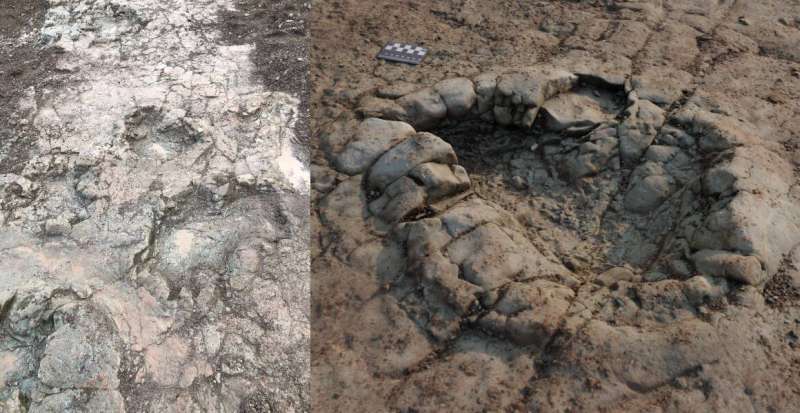The tracks are located on a public beach in Penarth, Wales and are thought to date back over 200 million years. Credit: NHM London/Peter Falkingham
Newly discovered imprints on a Welsh beach have been described as dinosaur footprints. The trackway dates from the Triassic, over 200 million years ago, and offers a unique snapshot of a moment in time.
In 2020, amateur paleontologist Kerry Rees got in touch with the Natural History Museum's Angela Marmont Centre to report finding what she suspected might be dinosaur footprints on the beach at Penarth in Wales. The images she provided were sent on to Museum paleontologists Dr. Susannah Maidment, Researcher, and Professor Paul Barrett, Merit Researcher.
The pair were initially skeptical. Dr. Maidment explains, "We get a lot of enquiries from members of the public for things that could be trackways but many are geological features that can easily be mistaken for them. However, from the photographs, we thought they were a fairly good contender for something that could be tracks and that it would be worth taking a look."
After consulting colleagues, it was found that the site had previously been investigated by a French team and a team from Cardiff University, as well as by Cindy Howells, National Museum of Wales, who is a co-author on the new paper. With differing opinions on what the impressions were, the researchers decided to work collaboratively and continue the investigation.
Dr. Maidment and Prof. Barrett visited the site to study it and take measurements. Prof. Barrett says, "We believed the impressions we saw at Penarth were consistently spaced to suggest an animal walking. We also saw displacement rims where mud had been pushed up. These structures are characteristic of active movement through the soft ground."
Less visible though were toe marks, the tell-tale sign of an animal footprint. Luckily the French team who had previously surveyed the site 10 years ago had images of the prints with less weathering which showed features like toe impressions. This not only provided the team further evidence that the impressions were indeed footprints but also suggested what the identity of the animal making them might have been.
The team now think that the impressions are an example of Eosauropus, which is a name not of a dinosaur but a type of track thought to have been made by a very early sauropod or near sauropod-relative, the group of dinosaurs that later included the famous Diplodocus.
Dr. Maidment says, "We know early sauropods were living in Britain at the time, as bones of Camelotia, a very early sauropod, have been found in Somerset in rocks dated to the same period. We don't know if this species was the track maker, but it is another clue which suggests something like it could have made these tracks."
Dinosaur trackways can provide a wealth of behavioral information to those studying them. They can show movement in herds and provide data on the way an animal may have walked.
Prof. Barrett concludes, "These types of tracks are not particularly common worldwide, so we believe this is an interesting addition to our knowledge of Triassic life in the UK. The record of Triassic dinosaurs in this country is fairly small, so anything we can find from the period adds to our picture of what was going on at that time."
Most institutions, including the Natural History Museum, don't generally collect footprints as storing them can be difficult with trackways sometimes going on for several hundred meters. These trackways have now been extensively investigated in the field and accurately documented for future study using state-of-the-art 3D imaging techniques.
The trail of footsteps, left over 200 million years ago by an early dinosaur, will remain on the shore in Penarth until the tide eventually erodes them away. In the meantime, it is hoped those who see them may be inspired to find out more about natural history.
The study, "Late Triassic dinosaur tracks from Penarth, south Wales," is published in the journal Geological Magazine.
More information: Peter L. Falkingham et al, Late Triassic dinosaur tracks from Penarth, south Wales, Geological Magazine (2021). DOI: 10.1017/S0016756821001308
Provided by Natural History Museum
























